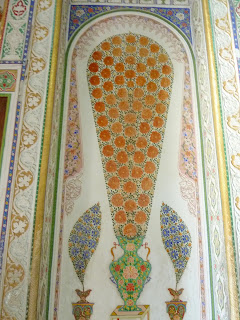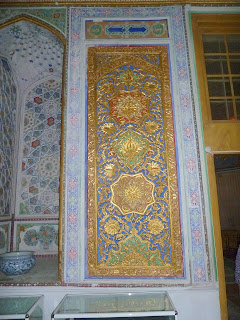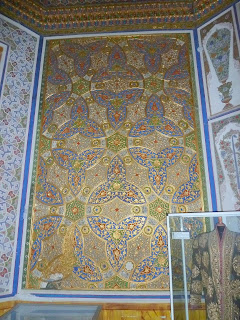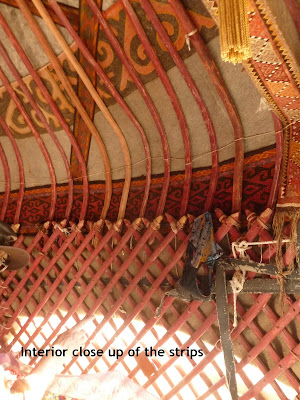Conn Iggulden is to blame for my wife's and my fascination with Mongolia and the Mongol Hordes. He is a British author who mainly writes historical fiction. After completing the Emperor series (based on Roman emperors), Iggulden’s new series was based on the life of Mongol warlords Genghis, Ogedai and Kublai Khan. His five books, Wolf of the Plains, Lords of the Bow, Bones of the Hills , Empire of Silver and Conqueror – revolve around the fascinating, cruel and harsh life of Genghis Khan and his descendants and the Mongol empire which was subsequently created. It’s a series which once begun, we had to finish. In fact, I have read one or two of the books again as one does not get tired of them.

We
have not been to Mongolia as yet (the diet is of great concern and I don’t like
carrying food with me on long trips) but we did recently travel the lower part
of the Silk Route and most important of all, stayed in a yurt – yes, okay, we
did it in relative comfort and did not sleep on raw hide carpets, but it was a yurt
in its full colourful glory.
The whole camp is dismantled at the end of the
season and re-made each year. The weather is too harsh to leave the yurts out
in the winter and spring months.
 |
| shows the lake |
One
of the adventures planned by our travel company (and you need a local agency
there as per Govt requirements) was a stay in a yurt camp. Like many of the
days, our departure was at 8.00 am sharp. Surprisingly, we were all punctual participants.
We had been clearly told to take minimum clothes for the 24 hour stay so we had
small backpacks on average.
We left Samarkand for Navoyi where we bought water
and some bread to eat at lunch... we were carrying cheese and fruit already. It
was here in a small shop by the roadside that I was stunned to see at least 25
brands of vodka in bottles of various sizes and shapes. Shelves of the stuff. Later,
in Tashkent, I found that alcohol shops abound. Near our hotel Gloria, within
less than a kilometre distance in a single direction, there were six liquor
vendors.
We stopped at Nurata with its famous ruins of Alexander the Great’s fortress and Chashma complex of the holy water spring and
Marinka fish – see my blog “The road less travelled -to Nurata” for details.
En route to the yurt camp, out in the middle of the desert, we stopped for a swim!! This is the Ayderkul Lake which was a complete surprise to us.


Lake Aydarkul is part of the man-made Aydar-Arnasay system of lakes, which covers an area of 4,000 square kilometres (1,500 mi²). This system includes three brackish water lakes (Aydar Kul, Arnasay and Tuzkan) located in the saline depressions of the south-eastern Kyzylkum desert (now in Uzbekistan and Kazakhstan). The lakes are the unintentional by product of Soviet planning. This and many other "unintended" lakes, such as Sarygamysh Lake with the immense capacity of 70 cubic kilometres of water) on the lower Amu Darya, created by the negligent Soviet planners, deny the Aral Sea about 150 cubic kilometres of annual inflow of water, directly contributing to, if not actually causing the latter's drying up. We went to the museum in Bukhara which teaches visitors the history of water supply in the Bukhara oasis. They feature a large scale map showing how the Aral Sea has dried up – see the photograph.

Today the area of Aydar Kul Lake is 3, 000 square meters; the length is nearly 250 km and width from 8 to 15 km. The area around the lake best suited for walks and rides on horseback and camelback. Fauna is rich. In spring and in summer alpine grasslands abound in variety of colours – bright-red tulips and snowy-white acacia.
High up in the mountains black storks build its nests. In early spring, when Arnasay is filled with water, thousands of ducks, geese, pelicans and herons flock together here.
We
stopped for 45 minutes whilst most of the group swam in the warm water. Outside
temp was in the high 30’s so I was not inclined to get out of the shade other
than for photography. There were swathes of wool lying around on the sand –
source unknown.
 At a particular place, after the swim, we moved over to a minivan as our
large coach would not be able to use the sandy rutted roads in the desert. At 5.00
pm, we reached the yurt camp. We were thrilled to be staying in one of these as
we had no idea what to expect.
At a particular place, after the swim, we moved over to a minivan as our
large coach would not be able to use the sandy rutted roads in the desert. At 5.00
pm, we reached the yurt camp. We were thrilled to be staying in one of these as
we had no idea what to expect.
 |
| First view of our camp |
 My wife and I were sharing, once again, with Robyn and Tim, an Australian
couple. There were yurts for single men
and single women. Out of the total 14 yurts, our group occupied the maximum –
there were three other smaller groups. Having left our bags, it was time to
explore. The yurt had power points and sufficient electric power wattage for me
to see clearly at night.
My wife and I were sharing, once again, with Robyn and Tim, an Australian
couple. There were yurts for single men
and single women. Out of the total 14 yurts, our group occupied the maximum –
there were three other smaller groups. Having left our bags, it was time to
explore. The yurt had power points and sufficient electric power wattage for me
to see clearly at night.


 There were two toilets each for women and men. There were 8 sinks – four with mirrors and four without. With a sinking heart, I felt we would repeat the saga of queues as in the Iskander kul guest house. However, to my complete surprise, despite there being nearly 30 people present (including all drivers, guides, travellers etc), I did not find any queues at all for the facilities.
There were two toilets each for women and men. There were 8 sinks – four with mirrors and four without. With a sinking heart, I felt we would repeat the saga of queues as in the Iskander kul guest house. However, to my complete surprise, despite there being nearly 30 people present (including all drivers, guides, travellers etc), I did not find any queues at all for the facilities.
 5.10 pm saw us all having tea followed by a camel ride for those
interested. These were actually dromedaries – two humped species. The ride was
for around 10 minutes and made a pleasant change from a car journey!! We all flocked up the small hill to see the
sunset which was scheduled for around 7.00 pm. It was a beautiful sight as the
sun went down.
5.10 pm saw us all having tea followed by a camel ride for those
interested. These were actually dromedaries – two humped species. The ride was
for around 10 minutes and made a pleasant change from a car journey!! We all flocked up the small hill to see the
sunset which was scheduled for around 7.00 pm. It was a beautiful sight as the
sun went down.
Then
we gathered around in small groups and had a few drinks before dinner was
served, as you see the spread for the starters was quite magnificent and
luckily quite tasty.
Meals locally are generally bland, less salt and no spices
of any sort. Even the kebabs are plain bar-b-q. So, we ate the starters more
than the main course. Dessert was fruit – melons and grapes.
In the late evening,
we had a bonfire going and nearly everybody joined the crowd around the fire.

Sleep,
beautiful sleep.... was I worried at all? No. The yurt has no lock except for a
wooden door to keep out the cold and possible wild animals. There was ample
ventilation through the slats of wood.
The beds were comfy and soon, I was
asleep. I was surprised to learn that after each season, these yurts are fully
dismantled and put away as they can’t take the winter weather. There is only
the kitchen structure which is semi solid.

Early
next morning, as you see from the photos, around 5.30am, I woke up. Never without
a camera in such areas, I was glad as I saw the sun gently coming up until one
side of the camp was lit and the other still remained in shadow. It was time to
move on soon after breakfast. ...............a yurting experience, if there was
one.

Don’t miss it if you get the chance. The silence, the flight back into Mongol
history, the ambience and camaraderie with total strangers. One of a kind.
Text and photographs copyright of the author. No part of this article or photographs maybe transmitted or reproduced by any means, electronic, mechanical, photocopying or otherwise, without written permission. Do contact the author on email -- helpthesun@gmail.com






















































































